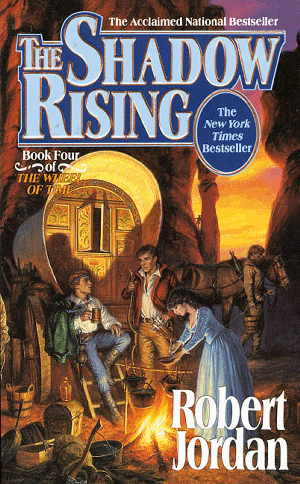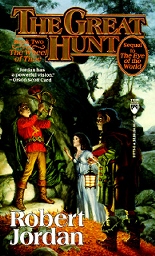
How could you possibly look ten women in the face and ask why they had gotten you drunk and made a game of taking your clothes off and putting you to bed?
Every long series has its fan favorite volume and for The Wheel of Time it’s book four, The Shadow Rising, coinciding also with the longest, at almost 400k words and 980 pages in the edition I read. Up to this point and including this one, each book, while relatively slow paced in itself, represented a different stage in the story. So where I expected formula I instead found a well defined arc with clear development. In this fourth book Jordan tends his garden.
There. I don’t think I could summarize what I’m going to write any better. I think it’s telling that this book, peculiarly since they were always there, lacks a Prologue. The way I see it there’s no prologue here because it’s the part of the book that usually teases the point of view of the bad guys (and girls, especially) before handing over the scene to the principal viewpoints (though it’s not a so strict structure and sometime you get other viewpoints as necessary). But book four mainly represents Team Good reforming and reorganizing. I knew already before reading the book that in this one the story opened up and laid the basis for what comes after, that it was essentially a foundation of the larger arc, but it takes quite a lot of pages to get the plot moving. In general, this where Team Good is on the move and plays its hand. So it’s not the bad guys who come forth, but Team Good taking the initiative to shake things up. It’s refreshingly “proactive”, instead of falling back in the norm of defending and confronting an imminent or latent threat. Despite this, Jordan still needs the imminent threat, even a number of them, so in the first part of the book a number of plot contrivances are tossed in just to keeps things supposedly tense, but in truth it’s all silly fakery. A pretense, smoke and mirrors whose purpose is linked to a bigger and more pervasive one I’ll explain later.
From a general outlook for the first 300 pages we mainly have characters looking around themselves to figure out what happened and where they stand, and decide (and argue muchly between them) what to do next. Then another 50 or so to actually get things moving. Past that point the book is split into three main branches, where each relies on a completely separate subplot, as if you get to follow three separate stories happening in different parts of the world to different characters. One follows Rand and his “initiative”, one Perrin and his woes, and another the girls and their affairs. And a fourth, minor page-wise, that deals with stuff elsewhere. They actually never converge, or get unified as the story goes, although some of the characters cross over. So for the first time, maybe, there’s an attempt to shape a world that has its own personality, in the sense that even if everything thematically pivots around Rand, stuff starts tumbling outward and the world outside claims its role. We see the ripples. It’s about the various parts of the world taking autonomy, instead of being empty stages waiting their turn as some main character passes through and experiences adventure. This happens timidly, but at least it happens, it is set as a goal. So while the first third of the book is rather shallow and not exactly matching the expectations for “best in the series”, overall the story is well sustained and interesting.
I imagine that for the fans the highest point is about getting to know more of the mythology and events from the past. There are scenes here that are meant to shape up things in a coherent whole, unify a number of different aspects and deliver more than a few revelations (especially those who enjoy to play with puzzle pieces). That part of the book could be considered fairly generous, and Jordan’s successful attempt to give some specific flavor to his world. But again, I can’t avoid thinking this is a giant fake, and that the true heart of the book is instead that shallow first third where characters bicker and fuss over petty things, and each other. That’s where the recipe is hidden in plain sight. The MUNDANE. Boys liking girls, girls liking boys. Tea times, sleepovers. Romantic love letters. Lots of pretty dresses and cleavages, or transparent silks and implied sauciness. This is it. The actual revelation here is the inverse of what you’d expect: the “fantasy” is meant to spice up the “romantic”, not the opposite. The fantasy is context, not subject. It is flavor, detail. Some window dressing so that the love story is more passionate and epic. Truly romantic and ideal. The fantasy is meant to add the required pathos that elevates a love story to its most idealistic extreme. Made wondrous. The shepherd isn’t a shepherd, but the predestined king in shiny armor that knows how to use a sword. But not just, because the love must be cursed, impossible. Never actually consumed. The longing dominates, because love stories need to be like that, always suspended, always slipping away. The boy wants the girl (or, actually, an harem), but he has more pressing matters because he has to be manly and save the world, first. Basically: adolescence. It’s adolescence stirred up in a mythical world. Essentially poison, in a way. In the sense that it’s super-effective. And that’s how I have (perhaps disrespectfully) reduced its popularity.
“Rand al’Thor,” Moiraine told the air in a low, tight voice, “is a mule-headed, stone-willed fool of a…a… a man!”
Elayne lifted her chin angrily. Her childhood nurse, Lini, used to say you could weave silk from pig bristles before you could make a man anything but a man. But that was no excuse for Rand.
“We breed them that way in the Two Rivers.” Nynaeve was suddenly all half-suppressed smiles and satisfaction. She seldom hid her dislike of the Aes Sedai half as well as she thought she did. “Two Rivers women never have any trouble with them.” From the startled look Egwene gave her, that was a lie big enough to warrant having her mouth washed out.
Moiraine’s brows drew down as if she were about to reply to Nynaeve in harder kind. Elayne stirred, but she could not find anything to say that would head off argument. Rand kept dancing through her head. He had no right! But what right did she have?
Then you may not agree with the extent of what I described, but it’s undeniable that it’s still there. If you think about it Martin’s ASOIAF isn’t all that different. It does the same thing but for more grown-up readers. Those hooks have similar shapes, in similar places. In both cases what’s familiar is used as a breach in the heart of the reader, grasp those familiar emotions and trappings that work so well in all forms of fiction, fantasy or not. The fantasy adds spice, elevates potentials. Inscribes into epic and memorable. Gives the writer unprecedented control (and responsibility). Characterization follows suit. Jordan does go after realism, but goes after iconic. I’d say characterization is extremely detailed and always well defined. Those characters need to stand apart, become familiar in the least amount of time. On top of this Jordan has a style of writing that is very expressive and “outward”, so you don’t find ambiguity and subtlety, but familiarity is the key to understand the characters perfectly and get absorbed in their story and personal woes and cravings. It is also an aspect where a formula shows. The smoothing of skirts and tugging of braids is now legendary and much sneered at, but I kind of respect it and find it as an actual strength that adds to characterization instead of subtracting. Why? Because this bundle of gestures and other small acts are used as a kind of characterization toolkit. So much redundant, but each expressive and carrying a very specific meaning. Each character has its own dedicated package, and each is used to convey a particular mood or sentiment. It makes characterization plain and, if I haven’t repeated it enough, hence familiar. Characters immediately recognizable, near to you so that you want to share. It works and it’s never overwrought because it always serves a point. Since the gesture conveys the state of mind, it is precisely necessary and efficient.
For someone who isn’t a Jordan fan, “best of Jordan” isn’t any better, but this book at least is more consistent and interesting compared to the duller and perfunctory 3rd. Characters step out of their lull on both sides, the evil foes start getting a personality and being more defined between each other, becoming characters and so giving more actual substance to a story that up to this point was merely against the usual abstract threat of some metaphysical evil. This also gets better nailed to the ground, more tangible and familiar. The story actually gains from having more of it revealed instead of shrouded into mystery. But then when you let character make the story it can also happen that they can unmake it. Perrin’s chapters would be at least nice but the way the character behaves makes them quite obnoxious. His relationship with Zarine is jarring because of how forced it is. It’s one of the cases where characters’ stereotypes are way more powerful than any realism. It reads like the most naive fairy tale and loses all its impact. And I actually like Zarine, compared to what I perceived as widespread hostility in the fandom. Thankfully there’s always a little bit of plot movement, myth development or mystery going on with obnoxious characters’ interactions. The book is readable even if slow paced, and overall a good experience comparable to the second volume, the one I liked the most up to this point.
Despite some plot moving parts and a general decent satisfaction in wrapping up the book, it’s not like what happened is so pivotal. Most of it is set-up, and some characters that are newly introduced absolutely go nowhere. They are basically entirely superfluous and it’s very clear they represent a part of the story that will play a role later on. It is a book that builds and moves, but only to load material on the rest of the series. Very little in this book happens for the sake of the book itself, and it’s maybe a success that it still feels satisfactory despite being mostly transition.
As I’m wont to do I started reading the 5th right as I finished this one. The end of the 4th is abrupt and really one big setup. You are meant to wonder: what now? And again it’s also a success that finishing the book made me enjoy a lot reading the prologue of the 5th. If I didn’t have a substantial reading queue I’d really like to just go on. As I said, this present book feeds the rest of the story, so that not only you may had a good experience reading it, but interest is sparked about what happens next. In a way, I could say that the very best part of book 4 is the prologue of book 5. And, less successfully, the more the book stays away from the main characters, the more it actually gets interesting and fun to read.
If one isn’t at peace with what I wrote in the first part, the mundane and the adolescent context, then it’s not going to be a series that can be digested. One would just bounce back on the irrelevant fluff and characters’ contrivances. You can’t even attempt to separate all that from worthwhile myth and worldbuilding. It does feel shallow and artificial. But if one is indeed an adolescent, or at least willing to impersonate one (!), then it’s really an enjoyable, epic story that carries on one’s dreams. It is generous and welcoming, and for this reason more “aware” and extrovert compared to the archaic Tolkien. Yet, while it is built to capture a large audience and remain as a classic, I believe its naive idealism won’t survive the times. Even younger readers now are jaded and cynical, as shaped by the world we live in, and maybe there’s not so much space left for the colorful, larger than life epic tales. It’s Jordan that appears archaic compared to Tolkien.

 I started this book while I was well into Infinite Jest and I needed something else that I could read with the brain turned off so that I could sleep afterward. Infinite Jest was getting me obsessed and The Dragon Reborn was perfect and made me sleep rather peacefully. With such premise one would think I’m already putting the book under a negative light, but that’s not completely true. I’m not masochist, I read slowly and have no time to read (and comment) books that I think are terrible, so if I finished even this one it means that I have at least enjoyed it to an extent. The kind of extent of enjoyment is a key element that I think is rather important not only from my personal perspective, but also in defining what is that makes this series so widely successful and popular.
I started this book while I was well into Infinite Jest and I needed something else that I could read with the brain turned off so that I could sleep afterward. Infinite Jest was getting me obsessed and The Dragon Reborn was perfect and made me sleep rather peacefully. With such premise one would think I’m already putting the book under a negative light, but that’s not completely true. I’m not masochist, I read slowly and have no time to read (and comment) books that I think are terrible, so if I finished even this one it means that I have at least enjoyed it to an extent. The kind of extent of enjoyment is a key element that I think is rather important not only from my personal perspective, but also in defining what is that makes this series so widely successful and popular. I don’t plan to turn this into a fantasy book review site because those reviews are in their own ways a literary work and I can’t expect to do it without a perfect grasp of English (which is again my second language). I also read slowly so I can’t make a satisfying blog with reviews. They would appear too rarely. So here are some conclusive considerations about “The Great Hunt”.
I don’t plan to turn this into a fantasy book review site because those reviews are in their own ways a literary work and I can’t expect to do it without a perfect grasp of English (which is again my second language). I also read slowly so I can’t make a satisfying blog with reviews. They would appear too rarely. So here are some conclusive considerations about “The Great Hunt”.